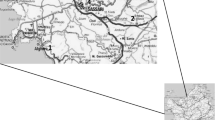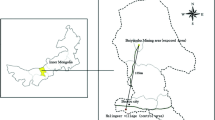Abstract
The effect of age and gender on 59 trace-element contents in rib bone of 80 apparently healthy 15–55-year-old women (n = 38) and men (n = 42) was investigated by inductively coupled plasma mass spectrometry. Mean values (M ± SΕΜ) for the mass fraction (milligrams per kilogram, on dry-weight basis) of Ba, Bi, Cd, Ce, Cu, Dy, Er, Gd, La, Li, Mn, Mo, Nd, Pb, Pr, Rb, Sm, Sr, Tb, Tl, U, Yb, and Zn for both female and male taken together were: Ba 2.5 ± 0.2, Bi 0.015 ± 0.002, Cd 0.044 ± 0.005, Ce 0.029 ± 0.002, Cu 1.05 ± 0.06, Dy 0.0020 ± 0.0003, Er 0.0011 ± 0.0002, Gd 0.0015 ± 0.0001, La 0.020 ± 0.002, Li 0.040 ± 0.002, Mn 0.354 ± 0.004, Mo 0.052 ± 0.006, Nd 0.011 ± 0.001, Pb 2.24 ± 0.14, Pr 0.0032 ± 0.0004, Rb 1.51 ± 0.06, Sm 0.0014 ± 0.0001, Sr 291 ± 20, Tb 0.00041 ± 0.00005, Tl 0.00050 ± 0.00003, U 0.0013 ± 0.0001, Yb 0.00072 ± 0.00007, and Zn 92.8 ± 1.5, respectively. The upper limit of mean contents of Ag, Al, B, Be, Br, Cr, Cs, Hg, Ho, Lu, Ni, Sb, Te, Th, Ti, Tm, and Y were: Ag ≤ 0.011, Al ≤ 7.2, B ≤ 0.65, Be ≤ 0.0032, Br ≤ 3.9, Cr ≤ 0.25, Cs ≤ 0.0077, Hg ≤ 0.018, Ho ≤ 0.00053, Lu ≤ 0.00024, Ni ≤ 1.05, Sb ≤ 0.0096, Te ≤ 0.0057, Th ≤ 0.0030, Ti ≤ 2.8, Tm ≤ 0.00006, and Y ≤ 0.0047, respectively. In all bone samples, the contents of As, Au, Co, Eu, Ga, Hf, Ir, Nb, Pd, Pt, Re, Rh, Sc, Se, Sn, Ta, V, W, and Zr were under detection limits. The Ce, Dy, Er, Gd, La, Nd, Pr, Sm, Tb, and Yb contents increase with age. Higher Sr mass fraction is typical of female rib as compared to those in male bone.
Similar content being viewed by others
References
Nevitt MC (1994) Epidemiology of osteoporosis. Rheum Dis Clin North Am 20:535–559
Orwoll ES, Bliziotes M (1994) Heterogeneity in osteoporosis. Men versus women. Rheum Dis Clin North Am 20:671–689
Melton LJ, Atkinson EJ, O'Connor MK, O'Fallon WM, Riggs BL (1998) Bone density and fracture risk in men. J Bone Miner Res 13:1915–1923
Cooper C, Atkinson EJ, Jacobsen SJ, O'Fallon WM, Melton LJ (1993) Population-based study of survival after osteoporotic fractures. Am J Epidemiol 137:1001–1005
Riggs BL, Melton LJ (1995) The worldwide problem of osteoporosis: insights afforded by epidemiology. Bone 17:505S–511S
Melton LJ (1993) Hip fractures: a worldwide problem today and tomorrow. Bone 14(suppl 1):S1–S8
Lentle B, Worsley D (2006) Osteoporosis redux. J Nucl Med 47:1945–1959
Rapp K, Becker C, Lamb SE, Icks A, Klenk J (2008) Hip fractures in institutionalized elderly people: incidence rates and excess mortality. J Bone Miner Res 23:1825–1831
Beattie JH, Avenell A (1992) Trace element nutrition and bone metabolism. Nutr Res Rev 5:167–188
Triffitt JT (1985) Receptor molecules, coprecipitation and ion exchange processes in the deposition of metal ions in bone. In: Priest ND (ed) Metals in bone. MTP Press, Lancaster, pp 3–20
Saltman S, Strause L (1993) The role of trace elements in osteoporosis. J Am Coll Nutr 12:384–389
Bowen HJM, Gibbons D (1963) Radioactivation analysis. The Clarendon Press, Oxford
Bowen HJM (1979) Environmental chemistry of the elements. Academic, London
Zwanziger H (1989) The multielemental analysis of bone: a review. Biol Trace Elem Res 19:195–232
Iyengar GV, Kollmer WE, Bowen HJM (1978) The elemental composition of human tissues and body fluids. A compilation of values for adults. Verlag Chemie, Weinheim
Iyengar GV, Tandon L (1999) Minor and trace elements in human bones and teeth. IAEA (NAHRES-39), Vienna
Grynpas MD, Pritzker KPH, Hancock RGV (1987) Neutron activation analysis of bulk and selected trace elements in bone using low flux SLOWPOKE reactor. Biol Trace Elem Res 13:333–344
Zaichick V (1997) Sampling, sample storage and preparation of biomaterials for INAA in clinical medicine, occupational and environmental health In: Harmonization of Health-Related Environmental Measurements Using Nuclear and Isotopic Techniques. IAEA, Vienna, pp 123–133
Zaichick V (2004) Losses of chemical elements in biological samples under the dry aching process. Trace Elem Med 5:17–22
Zaichick V, Zaichick S, Karandashev V, Nosenko S (2009) The effect of age and gender on Al, B, Ba, Ca, Cu, Fe, K, Li, Mg, Mn, Na, P, S, Sr, V, and Zn contents in rib bone of healthy humans. Biol Trace Elem Res 129:107–115
Zaichick V, Zaichick S (2009) Instrumental neutron activation analysis of trace element contents in the rib bone of healthy men. J Radioanal Nucl Chem 281:47–52
Hamilton EI (1979) The chemical elements and man. Charles C Thomas Publisher, Springfield
Kehoe RA, Cholak J, Story RV (1940) A spectrochemical study of the normal ranges of concentrations of certain trace metals in biological materials. J Nutr 19:579–588
Yoshinaga J, Suzuki T, Morita M (1989) Sex- and age-related variation in elemental concentrations of contemporary Japanese ribs. Sci Total Environ 79:209–221
Nusbaum RE, Butt EM, Gilmour TC, DiDio SL (1965) Relation of air pollution to trace metals in bone. Arch Environ Health 10:227–232
Yoshinaga J, Suzuki T, Morita M, Hayakawa M (1995) Trace elements in ribs of elderly people and elemental variation in the presence of chronic diseases. Sci Total Environ 162:239–252
Schroeder HA, Tipton IH, Nason AP (1972) Trace metals in man: strontium and barium. J Chron Dis 25:491–517
Samudralwar DL, Robertson JD (1993) Determination of major and trace elements in bones by simultaneous PIXE/PIGE analysis. J Radioanal Nucl Chem, Articles 169:259–267
Saiki S, Takata MK, Kramarski S, Borelli A (1999) Instrumental neutron activation analysis of rib bone samples and of bone reference materials. Biol Trace Elem Res 71–72:41–46
Forssen A (1972) Inorganic elements in the human body. Ann Med Exp Biol Fenn 50:99–162
Brättter P, Gawlik D, Lausch J, Rosick U (1977) On the distribution of the trace elements in human skeletons. J Radioanal Chem 37:393–403
Sumino K, Hayakawa K, Shibata T, Kitamura S (1975) Heavy metals in normal Japanese tissues. Arch Environ Health 30:487–494
Anke M, Schneider H-J, Grun M, Groppel B, Hennig A (1978) Die Diagnose des Mangan-, Zink- und Kupfermangels und der Kadmiumbelastung. Zbl Pharm 117:688–705
Crawford MD, Crawford T (1969) Lead content of bones in a soft and hard water area. Lancet 7597:699–701
Yamagata N, Murata S, Torii T (1962) The cobalt content of human body. J Radiat Res 3:4–8
Hamilton EI, Minski MJ, Cleary JJ (1972/73) The concentration and distribution of some stable elements in healthy human tissues from the United Kingdom. Sci Total Environ 1:341–374
Koch HJ, Smith ER, Shimp NF, Connor J (1956) Analysis of trace elements in human tissue. I. Normal tissues. Cancer 9:499–511
Nozaki T, Schikawa M, Sasuga T, Inarida M (1970) Neutron activation analysis of uranium in human bone, drinking water and daily diet. J Radioanal Chem 6:33–40
Byrne AR, Kosta L (1978) Vanadium in foods and in human body fluids and tissues. Sci Total Environ 10:17–30
Koch HJ, Smith ER, McNeely J (1957) Analysis of trace elements in human tissues. II. The lymphomatous disease. Cancer 10:151–160
Takata MK, Saiki M, Sumita NM, Saldova PHN, Pasqualucci CA (2005) Trace element determinations in human cortical and trabecular bones. J Radioanal Nucl Chem 264:5–8
Zaichick V, Dyatlov A, Zaichick S (2000) INAA application in the age dynamics assessment of maijor, minor, and trace elements in the human rib. J Radioanal Nucl Chem 244:189–193
Tzaphlidou M, Zaichick V (2003) Calcium, phosphorus, calcium-phosphorus ratio in rib bone of healthy humans. Biol Trace Elem Res 93:63–74
Acknowledgments
We are grateful to Dr. Sergey Moiseev (Forensic Medicine Department of Obninsk City Hospital) for supplying rib samples. The authors acknowledge the support of the ICP-MS determination in the framewok of the RAS Presidium program for basic research №20 “Creation and improvement of metods of chemical analysis and investigation of substances and materials structure”.
Author information
Authors and Affiliations
Corresponding author
Rights and permissions
About this article
Cite this article
Zaichick, S., Zaichick, V., Karandashev, V.K. et al. The Effect of Age and Gender on 59 Trace-Element Contents in Human Rib Bone Investigated by Inductively Coupled Plasma Mass Spectrometry. Biol Trace Elem Res 143, 41–57 (2011). https://doi.org/10.1007/s12011-010-8837-4
Received:
Accepted:
Published:
Issue Date:
DOI: https://doi.org/10.1007/s12011-010-8837-4




